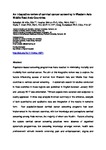Integrative review of cervical cancer screening in Western Asian and Middle Eastern Arab countries.
| dc.contributor.author | Ali, S | |
| dc.contributor.author | Skirton, Heather | |
| dc.contributor.author | Clark, MT | |
| dc.contributor.author | Donaldson, C | |
| dc.date.accessioned | 2018-01-16T13:07:02Z | |
| dc.date.issued | 2017-10-23 | |
| dc.identifier.issn | 1441-0745 | |
| dc.identifier.issn | 1442-2018 | |
| dc.identifier.uri | http://hdl.handle.net/10026.1/10589 | |
| dc.description.abstract |
Population-based screening programs have resulted in minimizing mortality and morbidity from cervical cancer. The aim of this integrative review was to explore the factors influencing access of women from Western Asian and Middle Eastern Arab countries to cervical cancer screening. A systematic search for studies conducted in Arab countries in those regions, and published in English between January 2002 and January 2017, was undertaken. Thirteen papers were selected and subjected to quality appraisal. A three step analysis was used, which involved a summary of the evidence, analysis of both quantitative and qualitative data, and integration of the results in narrative form. Few population-based cervical cancer screening programs had been implemented in the relevant countries, with low knowledge of, and perceptions about, cervical screening among Arab women, the majority of whom are Muslim. Factors affecting the uptake of cervical cancer screening practices were the absence of organized, systematic programs, low screening knowledge among women, healthcare professionals' attitudes toward screening, pain and embarrassment, stigma, and sociocultural beliefs. Policy changes are urgently needed to promote population-based screening programs. Future research should address the promotion of culturally-sensitive strategies to enable better access of Arab Muslim women to cervical cancer screening. | |
| dc.format.extent | 414-426 | |
| dc.format.medium | Print-Electronic | |
| dc.language | en | |
| dc.language.iso | en | |
| dc.publisher | Wiley | |
| dc.subject | Arab countries | |
| dc.subject | Muslim women | |
| dc.subject | Papanicolaou smear | |
| dc.subject | cervical cancer | |
| dc.subject | cervical screening | |
| dc.title | Integrative review of cervical cancer screening in Western Asian and Middle Eastern Arab countries. | |
| dc.type | journal-article | |
| dc.type | Journal Article | |
| dc.type | Review | |
| plymouth.author-url | https://www.ncbi.nlm.nih.gov/pubmed/29058371 | |
| plymouth.issue | 4 | |
| plymouth.volume | 19 | |
| plymouth.publication-status | Published online | |
| plymouth.journal | Nursing and Health Sciences | |
| dc.identifier.doi | 10.1111/nhs.12374 | |
| plymouth.organisational-group | /Plymouth | |
| plymouth.organisational-group | /Plymouth/Faculty of Health | |
| plymouth.organisational-group | /Plymouth/Research Groups | |
| plymouth.organisational-group | /Plymouth/Research Groups/Institute of Translational and Stratified Medicine (ITSMED) | |
| plymouth.organisational-group | /Plymouth/Research Groups/Institute of Translational and Stratified Medicine (ITSMED)/CBR | |
| dc.publisher.place | Australia | |
| dcterms.dateAccepted | 2017-07-20 | |
| dc.rights.embargodate | 2018-10-23 | |
| dc.identifier.eissn | 1442-2018 | |
| dc.rights.embargoperiod | Not known | |
| rioxxterms.versionofrecord | 10.1111/nhs.12374 | |
| rioxxterms.licenseref.uri | http://www.rioxx.net/licenses/all-rights-reserved | |
| rioxxterms.licenseref.startdate | 2017-10-23 | |
| rioxxterms.type | Journal Article/Review |


